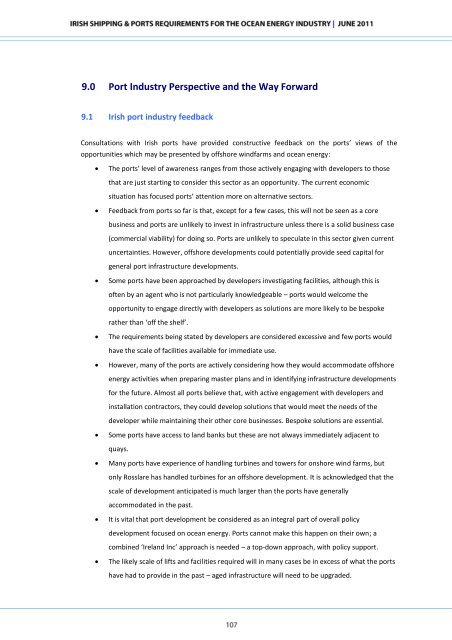Irish Shipping and Ports Requirements for the Ocean Energy Industry
Irish Shipping and Ports Requirements for the Ocean Energy Industry
Irish Shipping and Ports Requirements for the Ocean Energy Industry
Create successful ePaper yourself
Turn your PDF publications into a flip-book with our unique Google optimized e-Paper software.
9.0 Port <strong>Industry</strong> Perspective <strong>and</strong> <strong>the</strong> Way Forward9.1 <strong>Irish</strong> port industry feedbackConsultations with <strong>Irish</strong> ports have provided constructive feedback on <strong>the</strong> ports’ views of <strong>the</strong>opportunities which may be presented by offshore windfarms <strong>and</strong> ocean energy:The ports’ level of awareness ranges from those actively engaging with developers to thosethat are just starting to consider this sector as an opportunity. The current economicsituation has focused ports’ attention more on alternative sectors.Feedback from ports so far is that, except <strong>for</strong> a few cases, this will not be seen as a corebusiness <strong>and</strong> ports are unlikely to invest in infrastructure unless <strong>the</strong>re is a solid business case(commercial viability) <strong>for</strong> doing so. <strong>Ports</strong> are unlikely to speculate in this sector given currentuncertainties. However, offshore developments could potentially provide seed capital <strong>for</strong>general port infrastructure developments.Some ports have been approached by developers investigating facilities, although this isoften by an agent who is not particularly knowledgeable – ports would welcome <strong>the</strong>opportunity to engage directly with developers as solutions are more likely to be bespokera<strong>the</strong>r than ‘off <strong>the</strong> shelf’.The requirements being stated by developers are considered excessive <strong>and</strong> few ports wouldhave <strong>the</strong> scale of facilities available <strong>for</strong> immediate use.However, many of <strong>the</strong> ports are actively considering how <strong>the</strong>y would accommodate offshoreenergy activities when preparing master plans <strong>and</strong> in identifying infrastructure developments<strong>for</strong> <strong>the</strong> future. Almost all ports believe that, with active engagement with developers <strong>and</strong>installation contractors, <strong>the</strong>y could develop solutions that would meet <strong>the</strong> needs of <strong>the</strong>developer while maintaining <strong>the</strong>ir o<strong>the</strong>r core businesses. Bespoke solutions are essential.Some ports have access to l<strong>and</strong> banks but <strong>the</strong>se are not always immediately adjacent toquays.Many ports have experience of h<strong>and</strong>ling turbines <strong>and</strong> towers <strong>for</strong> onshore wind farms, butonly Rosslare has h<strong>and</strong>led turbines <strong>for</strong> an offshore development. It is acknowledged that <strong>the</strong>scale of development anticipated is much larger than <strong>the</strong> ports have generallyaccommodated in <strong>the</strong> past.It is vital that port development be considered as an integral part of overall policydevelopment focused on ocean energy. <strong>Ports</strong> cannot make this happen on <strong>the</strong>ir own; acombined ‘Irel<strong>and</strong> Inc’ approach is needed – a top-down approach, with policy support.The likely scale of lifts <strong>and</strong> facilities required will in many cases be in excess of what <strong>the</strong> portshave had to provide in <strong>the</strong> past – aged infrastructure will need to be upgraded.
















